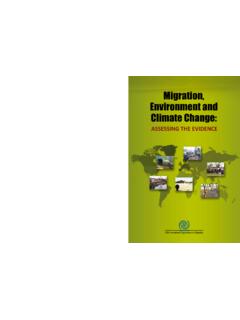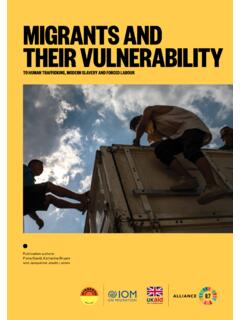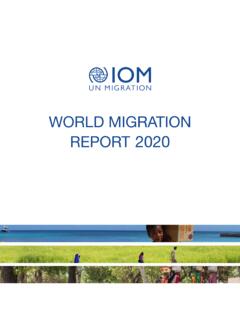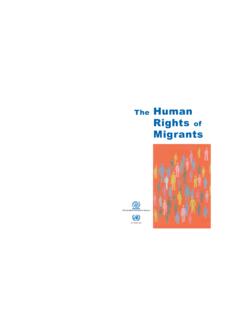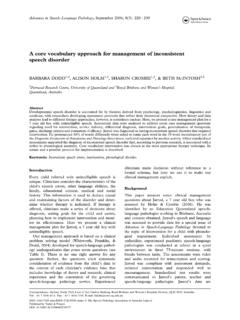Transcription of Glossary on Migration
1 Glossary on MigrationINTERNATIONAL INTERNATIONAL MIGRATIONMIGRATIONLAWLAWN 34N 34 The opinions expressed in this Glossary do not necessarily reflect the views of the International Organization for Migration (IOM). The designations employed and the presentation of material throughout the report do not imply the expression of any opinion whatsoever on the part of IOM concerning the legal status of any country, territory, city or area, or of its authorities, or concerning its frontiers or is committed to the principle that humane and orderly Migration benefits migrants and society. As an intergovernmental organization, IOM acts with its partners in the international community to: assist in meeting the operational challenges of Migration ; advance understanding of Migration issues; encourage social and economic development through Migration ; and uphold the human dignity and well being of : International Organization for Migration 17 route des Morillons Box 17 1211 Geneva 19 Switzerland Phone: + 41 22 717 91 11 Fax: + 41 22 798 61 50 Email: Website: 1813 2278 2019 International Organization for Migration (IOM)_____All rights reserved.
2 No part of this publication may be reproduced, stored in a retrieval system, or transmitted in any form or by any means, electronic, mechanical, photocopying, recording, or otherwise without the prior written permission of the publisher. 71_18 (230420) Glossary on MigrationINTERNATIONAL INTERNATIONAL MIGRATIONMIGRATIONLAWLAWN 34N 34iiiGlossary on MigrationFirst forewordEffective cooperation among relevant actors is probably more important in the Migration field than in any other policy areas. Not only do States sometimes speak different languages when dealing with Migration , but also actors within the same State often use an inconsistent vocabulary . Variations in the use of terms are also common depending on the person s field of law contributes to create some common denominators, through the definitions provided by international instruments that are binding on the States that are parties to them. Among the most significant examples are the definition of a refugee in the 1951 Refugee Convention or the ones contained in the two Protocols on Smuggling of Migrants and Trafficking in Persons to the United Nations Convention against Transnational Organized Crimes.
3 Transnational cooperation would never be effective without a common understanding of the elements of the crimes prosecutors are responsible to fight, and burden sharing could never become a reality without the commitment of many States to protect those who flee persecution. In other instances, States have pushed for a more humane approach to Migration by calling on the international community to put an end to the use of dehumanizing terms associated with Migration , such as illegal migrants , in favour of the more neutral attribute of migrants in an irregular situation . And these types of shift in the use of terminology are not only for the sake of political correctness but also to contribute to shaping the perception that we have of Migration realities. The rise in the use of negative or alarmist terms in recent public discourse around the world have similarly impacted, although negatively in this case, the way migrants are the time of releasing this Glossary , the adoption of the Global Compact for Migration has sparked renewed attention to Migration realities.
4 It is thus a critical moment to try to contribute to the consolidation of not only a uniform but also a correct and balanced approach to Migration nio VitorinoDirector GeneralInternational Organization for MigrationvGlossary on MigrationSecond forewordWelcome to the IOM Glossary on like that, it sounds as if this document would solve all issues related to how we speak about, address and find solutions to concerns around Migration . It will not. What this document aims at doing is to give definitions for commonly (and on occasion not so commonly) used terms when speaking Migration . Some are definitions which are found in legal documents and as such very fixed. Others are terms which are found in soft law documents and as such equally fixed. Some are working definitions and may vary slightly from actor to actor who use them when they work. With this, we hope to perhaps bring some harmony in the way terminology is used. What this Glossary does not do is to define complex issues: it is a Glossary , not a collection of dissertations.
5 Nor does it solve all discussions on complex issues, nor does it attempt to put a stop to ongoing discussions on concepts and issues which are constantly evolving. It does not contain the final truth. What this document does is contribute to the ongoing discussion on the complex concepts and bring clarity on concepts and terms which have either legal or long standing definitions already. Our hope is that, while you will not find answers to all your Migration related questions in this Glossary , you will find many of the terms and concepts you use when discussing Migration , some of which are widely agreed upon and others which are still debated. We consider the Glossary a living document, which will only be available online so that it can be regularly updated to reflect the evolving use of the language. The creation of this Glossary took a great amount of time, as hard labour from many stakeholders was poured into it. We consulted with other international organizations, academia, civil society and IOM offices around the world all of their observations were precious and made this a better and more comprehensive would like to end this with very special thanks to Alice Sironi and C line Bauloz in particular, and the International Migration Law team including previous members such as Milen Emmanuel theirs was the sweat and tears that went into these pages.
6 Kristina TouzenisHead, International Migration Law UnitviiGlossary on MigrationEditorial, review and production teamEditors: Alice Sironi, C line Bauloz and Milen Emmanuel IOM reviewers: IOM Headquarters: Department of Operations and Emergencies (DOE), including Preparedness and Response Division (PRD), Resettlement and Movement Management (RMM), Transition and Recovery Division (TRD); Department of Migration Management (DMM), including Immigration and Border Management Division (IBM), Labour Mobility and Human Development Division (LHD), Migrant Protection and Assistance (MPA), Migration , Environment and Climate Change Division (MECC), Migration Health (MHD); Department of International Cooperation and Partnerships (ICP), including Multilateral Processes Division (MPD), International Partnership Division (IPD) and Migration Research Division (RES); Office of the Director General (ODG), including Global Compact for Migration , Gender Coordination Unit (GCU) and Office of Legal Affairs (LEG) Regional Offices (ROs): RO Cairo, RO Brussels, RO Nairobi and RO ViennaGlobal Migration Data Analysis Centre (GMDAC)Academic reviewers: J rgen Carling, Vincent Chetail, Kathleen Newland, Martin Ruhs and Laura Van WaasReview by UN Organizations: Office for the Coordination of Humanitarian Affairs (OCHA), the Office of the High Commissioner for Human Rights (OHCHR), UNICEF and the United Nations High Commissioner for Refugees (UNHCR)Production coordination and review: Valerie HaggerDesign and layout: Ramir Recinto and Publications UnitIOM team: Anne Althaus, Fanny Dufvenmark and Kristina Touzenis ixGlossary on MigrationAcknowledgementsThe editors are grateful to the following external experts who provided valuable comments to this new edition of the Glossary on Migration .
7 J rgen Carling, Vincent Chetail, Kathleen Newland, Martin Ruhs and Laura Van thanks must also be extended to the following representatives of United Nations organizations or institutions who provided their inputs to the draft Glossary : Sarah Rahman and Hansjorg Strohmeyer from the Office for the Coordination of Humanitarian Affairs (OCHA), Ben Lewis and Pia Oberoi from the Office of the High Commissioner for Human Rights (OHCHR) and Mirela Shuteriqi from UNICEF. The editors are particularly grateful for the thorough review and continuous support received from Madeline Garlick, Claire Inder, Michele Cavinato, Cameron Shilton and Cornelis Wouters from the United Nations High Commissioner for Refugees (UNHCR).This new edition would have not been possible without the many valuable contributions received during the extensive process of development of the Glossary on Migration from the following IOM colleagues or former colleagues, both at Headquarters and in the field.
8 Mohammed Abdiker, Christine Adam, Eugenio Ambrosi, Jason Aplon, Gervais Appave, Eliana Barragan, Tristan Burnett, Maurizio Busatti, Alessia Castelfranco, Sacha Chan Kam, Patrick Corcoran, Phyllis Coven, Phoonam Dhavan, Noelle Darbellay, Jo De Backer, Julia De Bresser, Bethany Donithorn, Olivier Ferrari, Florian Forster, Elisa Galos, Kristina Galstyan, Nicoletta Giordano, Nicola Graviano, Sam Grundy, Lorenzo Guadagno, Salvador Gutierrez, Renate Held, Jill Helke, Julia Hill Mlatis, Dina Ionesco, Lee Kanthoul, Ginette Kidd, Alice Kimani, Michele Klein Solomon, Sarah Knight, Heather Komenda, Geertrui Lanneau, June Lee, Sieun Lee, Kristiina Lilleorg, Laura Lungarotti, Marina Manke, David Martineau, Lea Matheson, Luciano Mathieu, Marie McAuliffe, Kerry Lynn Maze, Susanne Melde, Daria Mokhnacheva, Craig Murphy, Alina Narusova, Anh Nguyen, Karoline Popp, Etienne Quillet, Marzia Rango, Johan Rautenbach, Jennifer Rumbach, Tauhid Pasha, Stephen Pindie, Fatma Said, Angela Staiger, Theodora Suter, Agn s Tillinac, Christina Vasala Kokkinaki, Elizabeth Warn, Sanjula Weerasinghe, Jacqueline Weekers, Lara White, and Vassiliy Migration LAWWe are particularly grateful to Valerie Hagger for her competent supervision of the whole production process and for her meticulous editing of the Glossary , as well as to Ramir Recinto for his work on the layout and for his patience in incorporating numerous changes into the final draft.
9 Finally, we wish to express deep and sincere gratitude to colleagues of the IML team, Anne Althaus, Fanny Dufvenmark and Kristina Touzenis, who provided us with meaningful insight and continued support throughout the on MigrationIntroductionSimilarly to previous ones, this edition of the IOM Glossary on Migration is an accessible collection of definitions of Migration related terminology. It is designed for a broad range of persons engaging with Migration at the international level. It also provides some insights on regional and national purpose of this edition, like previous versions, is to develop a common understanding and consistent use of Migration and Migration related terms based, whenever possible, on international standards. Creating uniformity in language is an important starting point in Migration discourse to ensure an accurate understanding and coherent exchange of information among actors working in the field of Migration . Most importantly, it is a fundamental step towards collective and more efficient responses.
10 In some cases, the use of appropriate Migration terms can foster an objective and balanced approach to Migration , support States in better fulfilling their human rights obligations towards migrants, and have a positive impact on State and public perceptions on Migration . Following on from previous editions, this Glossary provides a wide set of terms pertaining to conceptual, legal, theoretical or practical matters of Migration . This version has been streamlined and entries included in the previous version that were only remotely linked to Migration have been omitted. Moreover, acknowledging that any Glossary should be a constant work in progress that changes to follow the evolving use of the language, several definitions have been revised in this edition to reflect recent developments (including the definition of migrant ). New terms that are now a part of Migration discourse have also been added. These include, for example, many terms in the area of environmental Migration , such as climate Migration and disaster displacement , the various meanings of the term relocation within the European Union or in the context of climate change, as well as the current use of the term human mobility to describe the multitude of ways in which people move from one place to another.


